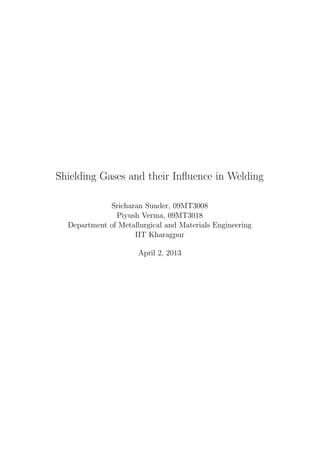
Shielding Gases and their Influence in Welding
- 1. Shielding Gases and their Influence in Welding Sricharan Sunder, 09MT3008 Piyush Verma, 09MT3018 Department of Metallurgical and Materials Engineering IIT Kharagpur April 2, 2013
- 2. Abstract During a welding process, oxygen and other atmospheric gases can react with molten metal causing defects that weaken the weld. The primary function of a shielding gas is to protect the molten weld from atmospheric contamina- tion and resulting imperfections. In addition to its shielding function, each gas or gas blend has unique properties, weld appearance and shape, fume generation, weld color, and arc stability. The primary gases used for electric welding and cutting are argon, helium, hydrogen, nitrogen, oxygen, and carbon dioxide. The composition of the gas can and should be tailored to meet the process, material, and application requirements.
- 3. Introduction For all practical purposes, a welding arc can be thought of as a conversion device that changes electrical energy into heat. Arc temperatures are very high, producing more than enough heat to melt any known matearial. The characteristic of an arc depends on the shielding gas that is used in the arc gap because the gas affects the arc constituent i.e. the anode, cathode, and plasma regions of the arc. To form the arc plasma the shielding gas must be forced to remove an electron from a gas atom, making it an ion, or electrically charged gas atom. This is referred to as ionization. The heavier the gas atom the easier it is to ionize the lighter is harder to ionize. Since heat in the arc is roughly measured by the product of current and voltage (arc power), the use of helium yields a much higher available heat than does argon. Conversely you can understand that since argon ionizes at a lower voltage it will initiate the arc easier than does helium. 1
- 4. Influences and Effects of Various Shielding Gases on Different Properties Dissociation and Recombination When two or more atoms combine they form a molecule. Shielding gases such as hydrogen and oxygen are molecules. When gases such as hydrogen are heated to the temperatures present in the arc plasma, these gases break down, or dissociate into their separate atoms. They are then at least par- tially ionized, producing free electrons and current flow. As the dissociated gas comes in contact with the relatively cooled work surface, the atom s re- combine, and in the process generate additional heat. This process does not occur with gases such as argon, which cons ists of a single atom. Therefore, at the same arc temperature, the heat generated at the work surface can be considerably greater with gases such as hydrogen and oxygen. Reactivity Reactivity, as it applies to shielding gases, is a comparative measurement of how readily a given sh ielding gas will react with the molten weld metal. Nitrogen is sometimes considered an inert gas. However, at the temperatures associated with weldings, it may react and have an effect on weld chemistry. Hydrogen also reacts with the weld metal but as a reducing gas. Hydrogen will (preferentially) react with an oxidizing agent over the molten weld metal, thereby helping to prevent the formation of oxides in the molten weld metal. Surface Tension In any liquid there is an attractive force exerted by the molecules below the surface upon those at the surface. An inward pull, or internal pressure is thus created, which tends to restrain the liquid from flowing. Its strength varies with the chemical nature of the liquid. In welding, the surface tension between molten metals and the surrounding atmosphere has a pronounced influence on bead shape. If the energy value is high, a convex, irregular bead will result. Low values promote flatter beads. Pure argon shielding is usually associated with high interfacial energy, pro- ducing sluggish puddle and a high crowned bead. This is partially attributed to the high surface tension of liquid iron in a inert atmosphere. 2
- 5. Gas Purity Depending on the metal being welded and the welding process used, even very minute gas impurities can have a significant effect on welding speed, weld surface appearance, weld bead coalescence, weld color, and porosity levels. The effects of any given impurity, either by itself or in combination with others, on the many metals and processes available create endless pos- sibilities. There is always the possibility of the gas being contaminated either as delivered, or more likely, somewhere between the supply and the end use point. Your shielding gas supplier is equipped with the analytical equipment to determine purity levels anywhere in the system, and in most cases will assist in identifying the cause and solution. Flow of Shielding Gas The proper flow of shielding gas is a very important factor for high quality welding. Insufficient or excessive amounts of shielding gas can have negative affects on welding quality. Excessive gas can cause turbulence to occur and air contamination to be introduced; this causes oxidation and discoloration of the weld deposit. Insufficient gas flow can also result in poorly protected welds that is, oxidation from the air can occur, and once again oxidized and discolored weld deposits can be produced. While discolored deposits depending on application, may only be cosmetically displeasing the presence of oxide can reduce mechanical properties (strength and fatigue) and reduce toughness. Conclusion So it can be seen that as a matter of fact, the shielding gases are very much responsible for the surface finish and the properties of the weld as the shielding gases effect a lot of other factors which determine the weld directly or indirectly. It also effects the drop radius as follows. 3
- 6. Thus we can see that the shielding gas also effects the droplet size that is released from the electrode and hence controls the volume of filler metal going per unit time into the weld. 4
